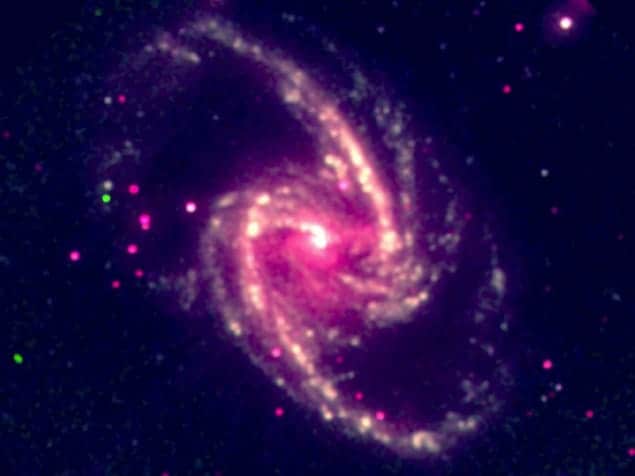
The best evidence yet that some supermassive black holes (SMBH) rotate at extremely high rates has been found by an international team of astronomers. Made using the recently launched NuStar space telescope, the study suggests that a huge black hole at the centre of a distant galaxy acquired a huge amount of rotational energy as it formed. The discovery could provide important information about how SMBHs and their associated galaxies form and evolve.
Astronomers know that black holes that are as large as a billion solar masses can be found at the heart of most galaxies. Because these gravitational behemoths are created at the same time as their host galaxies, understanding how they formed could provide important information about galaxy formation and evolution.
Knowing the spin of an SMBH can provide important clues about how it formed. If the black hole grew slowly, by sucking in small amounts of matter from all directions, then it isn’t expected to have much spin. However, if the formation process involves the black hole gorging rapidly on matter from a specific direction, conservation of angular momentum would leave it with an extremely large spin.
Redshifted X-rays
The spin of a supermassive black hole can be measured by looking at the effect that the spin has on material that is being sucked in to the black hole. This material forms an accretion disc that swirls around the black hole before disappearing from sight. The faster the black hole is spinning, the closer the inner edge of the disc is to the centre of the black hole. As a result, the X-rays emanating from the inner edge are affected by the black hole’s gravity more when the black hole is spinning.
Astronomers see this as a “stretching” of the wavelength (redshift) of characteristic X-rays emanating from iron and other elements in the accretion disc. By measuring the redshift, the spin of the black hole can be deduced.
The problem, however, is that these X-rays must first travel through fast-moving clouds of gas that surround the accretion disc. The absorption of X-rays by the gas could mimic the effect of a spinning black hole. As a result, astronomers have not been that confident about their estimates of black-hole spin.
Sensitive at higher energies
Now, Guido Risaliti of the Arcetri Observatory in Florence and astronomers in the US, Denmark and the UK have separated the redshift and cloud effects using data from NASA’s NuSTAR space telescope – which was launched in June 2012 – along with data from the European Space Agency’s XMM-Newton space telescope. Unlike other instruments that are sensitive in the 0.5–10 keV range, NuStar can detect X-rays in the 3–80 keV energy range. The instrument’s excellent sensitivity at higher energies means that it can tell the difference between the effects of gas absorption and spin on the X-rays.
Risaliti and colleagues pointed the telescopes at the SMBH at the centre of the galaxy NGC1365, which is about 56 million light-years away. This black hole, which is about 2 million times more massive than the Sun, is of particular interest because previous studies had suggested that it was rotating rapidly.
The results suggest that if cloud absorption were the only process affecting the X-rays, then the clouds must be so dense that they absorb up to 98% of the X-rays created in the accretion disc. But if this were the case, then the cloud would quickly absorb vast amounts of energy and then blow apart.
Vast amounts of rotational energy
As a result, Risaliti and colleagues concluded that the spinning black hole did affect the X-rays emitted from the accretion disc. The study confirms that the SMBH is spinning at a rate close to the limit defined by the general theory of relativity. While the rotational properties of a spinning gravitational singularity are difficult to describe in a simple way, Risaliti explains that the rotational energy of the SMBH at the heart of NGC1365 is about the same as the energy that is given off by a billion stars burning for a billion years.
Risaliti tells physicsworld.com that the team is currently looking at observations of NGC1365 in an attempt to understand why the X-ray spectrum changes over time. The spin of an SMBH is expected to be constant, therefore these changes should be related to variations in the accretion disc and other structures close to the black hole.
In the longer term, he believes that studies of SMBH spin in galaxies throughout the universe will provide important information about the formation and evolution of galaxies.
The observations are described in Nature.



